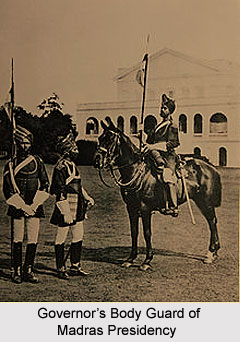 The Governor`s Body Guard of Madras Presidency, also known as Governor`s Bodyguard Madras, was a former military regiment of the British Indian Army. Founded in the year 1778, it was dissolved in 1947. The British Indian army raised 3 bodyguard units for the three major Presidencies in British India, namely Madras Presidency, Bengal Presidency and Bombay Presidency. The body guard regiments were designated as Governor`s Body Guard. The Governor`s Body Guard of Madras Presidency was a part of the Madras Army, before the Great Revolt of 1857. The army forces of Madras Presidency were amongst the 3 largest Presidency Armies in British India. The Army of the Madras (now Chennai) was raised with the aim of defending the commercial involvements of the East India Company. These units were under the administrative rule of the British East India Company until climax of the Sepoy Mutiny in 1857.
The Governor`s Body Guard of Madras Presidency, also known as Governor`s Bodyguard Madras, was a former military regiment of the British Indian Army. Founded in the year 1778, it was dissolved in 1947. The British Indian army raised 3 bodyguard units for the three major Presidencies in British India, namely Madras Presidency, Bengal Presidency and Bombay Presidency. The body guard regiments were designated as Governor`s Body Guard. The Governor`s Body Guard of Madras Presidency was a part of the Madras Army, before the Great Revolt of 1857. The army forces of Madras Presidency were amongst the 3 largest Presidency Armies in British India. The Army of the Madras (now Chennai) was raised with the aim of defending the commercial involvements of the East India Company. These units were under the administrative rule of the British East India Company until climax of the Sepoy Mutiny in 1857.
The authority of the British Presidency Armies was later transferred after the Government of India Act 1858 was authorized. The control was reassigned to the British Empire in India from the British East India Company. The Presidency Armies, namely the Bombay Army, the Bengal Army and the Madras Army, were eventually merged to form the united British Indian Army in 1903.
History of Governor`s Body Guard of Madras Presidency
The Governor`s Body Guard of Madras Presidency the one of the most senior units amongst the 3 Governor`s Body Guard regiments. Initially it included one Corporal, one Sergeant and 12 European troopers and Lieutenant P. Sullivan acted as the Commanding Officer. The Governor`s Body Guard of Madras held its designation from its inception throughout the various re-organizations, unlike the other regiments of Madras Army, even though the military strength and constitution of the regiment changed a number of times.
The unit contained 1 European troop in the year 1778 and later in 1781, it was increased to 1 European and 1 Native troops. Later the European troop was dissolved in the year 1784 and company of the light infantry was also raised. By the year 1799, military capability of the Governor`s Body Guard of Madras was modified to 100 army personnel. The Body Guard unit also received a standard from Lord Willingdon in the year 1924. Initially the regiment comprised only European troops; but after the year 1781, South Indian classes mainly commanded the unit, including the Deccani and Madrasi Muslims. In the year 1947, it consisted of Jats from Punjab and Rajputs from Rajasthan.
Military Operations of Governor`s Body Guard of Madras Presidency
The regiment provided service in the Anglo Mysore war and the Persia. Later battalions from various Madras cavalry regiments were merged with the body guard units on rotation from 1808 to 1820. The military unit participated in the Third Anglo Maratha War (1817- 1819). The regiment was awarded with the Battle Honour Seetabuldee for the relief of Nagpur Residency during the war. The Governor`s Body Guard of Madras Presidency also fought in the First Burma War (1824- 1826) and rescued the advance guard at Pagan from the rival force.
The body guard unit later served in the First World War under the British Indian Army and served as a remount training center. A united force was raised from the detachment from Madras Body Guards and Bombay Body Guards, which was sent to France. The Governor`s Body Guard of Madras Presidency was dissolved in the year 1947.



















